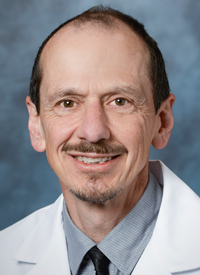Blood & Marrow Transplant Outcomes Exceed Expectations
The Cedars-Sinai Cancer Blood & Marrow Transplant Program’s one-year patient survival rate exceeded expectations compared to transplant centers in the U.S. whose similar patients underwent allogeneic transplants.
Ronald L. Paquette, MD

The Cedars-Sinai Cancer Blood & Marrow Transplant Program’s one-year patient survival rate exceeded expectations compared to transplant centers in the U.S. whose similar patients underwent allogeneic transplants, according to a national report that tracks those outcomes.
Allogeneic transplants involve transferring healthy blood stem cells from a related or unrelated person into a patient with leukemia, lymphoma or other blood disorder. The procedure takes place after a patient’s own unhealthy bone marrow has been treated with high-intensity chemotherapy with or without radiation to kill the abnormal cells. It can result in long-lasting remission or a cure.
The recent report was prepared by the Center for International Blood & Marrow Transplant Research—a collaboration between the National Marrow Donor Program/Be The Match and Medical College of Wisconsin. The report analyzed one-year blood and marrow transplant survival rates among U.S. transplant centers, from Jan. 1, 2017, through Dec. 31, 2019.
Cedars-Sinai Cancer’s Blood & Marrow Transplant Program is one of 10 U.S. adult transplant centers that performed above the expected survival rate, according to the report. The Center for International Blood & Marrow Transplant Research rating system provides an overall risk-adjusted analysis indicating whether the one-year survival rate is “below expected,” “as expected” or “above expected” for each transplant center, compared to an average transplant center in the U.S. There are about 200 transplant centers nationally; 173 of them are included in this year’s analysis.
“These one-year survival rates are a validation of the exceptional quality of our program,” said Ronald L. Paquette, MD, clinical director of the Stem Cell and Bone Marrow Transplant Program at Cedars-Sinai Cancer. “They reflect the practices we have carefully honed to potentially cure as many patients with blood cancers as possible.”
How Transplant Center Survival Outcomes Are Rated
Outcome expectations are determined by a specialized, multivariant analysis that includes the patient’s age, performance status on tests, additional medical issues, family support structure, socioeconomic viability, and the patient’s motivation to participate in self-care, according to the center. Additionally, potential transplant patients typically undergo a detailed health history, physical examination and clinical testing to assess their physiological status.
“Before a blood or bone marrow transplant is considered, potential patients must undergo conditioning regimens that vary significantly by transplant center, physician and patient,” Paquette explained. “The doctor determines which combination of chemotherapy drugs with or without radiation would be best to kill the cancer cells.”
The types of treatments and doses sometimes are mixed and matched, depending on the patient, Paquette added. “Every center has its own recipe that they prefer. How well patients handle those regimens plays a role in their survival outcomes.”
The Cedars-Sinai Blood & Marrow Transplant Program performed about 40 allogeneic transplants per year over the last three years, Paquette said. About 120 transplants typically are performed at Cedars-Sinai yearly, including autologous stem cell transplants, which use healthy blood stem cells from a patient’s own body to replace diseased bone marrow.
Recipe for Success
Over the last decade, the Cedars-Sinai Cancer Blood & Marrow Transplant team has refined its pre- and post-transplant regimens, Paquette said, which contributed to significant improvement in the program’s survival outcomes. These refinements include eliminating pre-transplant regimens associated with higher rates of toxicity or death.
“We have to weigh the risks and benefits of pre-transplant treatments,” Paquette said. “We measure the patient’s performance status during a lung function test, for example, and their age and physical fitness. We’ve narrowed down the regimens that are safe and effective,” including for older people, who historically were not offered transplants due to the increased risk of cancer relapse and other serious health issues that could affect their survival.
One of the most worrisome transplant side effects is graft versus host disease, a condition in which the donor’s bone marrow or stem cells perceive the recipient’s healthy cells as foreign and attack them. This condition can be life-threatening. With the help of certain medicines, transplanted cells begin to accept the new body and don’t attack it, but “it’s a dance,” says Paquette.
“It’s hard to know exactly what will happen with a transplant patient. Any one thing can go wrong,” Paquette said. “We cannot check every possibility. We have to do things empirically, focusing on regimens that may possibly move the field forward.”
“As a team, we have found a successful formula that has produced a significant difference in our survival outcomes,” Paquette added. “We are proud of that success and continue to improve it.”
Read a first-person account of a successful bone marrow transplant on the Cedars-Sinai Blog: The Long Path to Bone Marrow Transplantation



